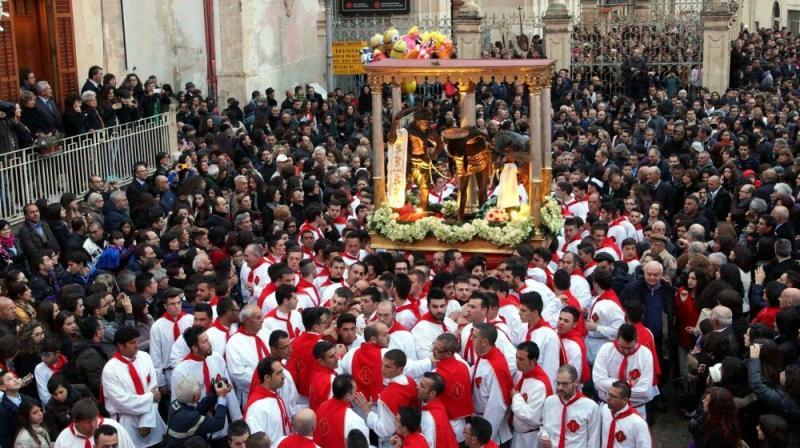Celebrations and Rites of Holy Week in Scicli
The Rites of Holy Week
The week preceding Easter is marked by various processions and celebrations.
The afternoon of Palm Sunday, the simulacrum of the A.ddolorata of Santa Maria la Nova, still today at the center of the veneration of all citizens, è linked to an ancient cult that dates back to S. Guglielmo.
A large crowd of faithful, in a double row, silent, in an attitude of prayer, carrying lighted torches with a bridle paper collar, to protect the flame, follows The pity; the statuary group is made up of a wooden sculpture, the Madonna, lying down, with her head bent, her hair falling down on her chest, with a floral dress, a golden shirt and a blue damask cloak that supports the deposed Christ on her knees; flanked by two pious women, standing upright and, next to it, a wooden cross covered with silver sheets. At one time, and up to the middle of the last century, it was not uncommon to see some penitents, their torso naked, under an abracian coat, their head encircled by a thorny twig, clapping their shoulders, in rhythm, with a donut of rope made of canape". (B. Cataudella, "Scicli. History and Traditions").
Il Holy Tuesday is the processionand of the Addolorata di S.Bartolomeo, "Lu veru Cravaniu", a rite introduced more recently, as if to underline the rivalry between the two Confraternities.
The "function" of the Holy thursday, with the setting up, in the chapels of the various churches, of the "Saburcara", the Sepulchres, which must be visited, as tradition dictates, in an odd number. The older ones remember that once the two simulacra, of Gesù at the column and of the Gesù at the "tympone", were transported, in noisy raids, one up to Balata, the other up to Calvary, under the Convent of Cross; the party then continued also during the night, "... with a silent procession, in an atmosphere of sadness, which was fitting for a rite of Passion, during which the Dies ira, dies illa was sung". (B. Cataudella, op.cit.)
Very suggestive is the evening of Good Friday, when a beautiful simulacrum of Our Lady of Sorrows, called "of the Hospital " because it was already kept and venerated in the demolished church of the hospital.
Dressed in the traditional black dress and a sword that pierces her chest, she was also called Madonna of the craftsmen, as once the city workers took turns at the poles.
This Madonna, currently venerated in the church of San Giovanni, attracts a continuous flow of faithful in which it ignites feelings of authentic religious piety, testified by the numerous associations that operate and spread the Marian cult in her name.
The procession begins, in fact, from the church of San Giovanni and, in an atmosphere of great meditation, goes towards the church of Santa M. la Nova where other faithful are already waiting with the ferculo of the "Dead Christ", kept inside a glass case that is placed at the head of the procession; to follow, the statue of "Christ at Calvary and the Jews" it's a "ecce Homo "; composed in this way, the procession, between songs and prayers, runs through the main streets of the city, until late in the day.
From this moment the city seems to live with bated breath, in religious silence, the arrival of Saturday when, at midnight, with the function of the "Scisa a Cruci" , "Snap", (melt) the bells, after the long silence that lasts from Holy Thursday and, in a festive competition, the bells of the Matrix ring out, then, in order, thunders, in the valley, the bell of the church of San Bartolomeo and, lastly those of Santa M. la Nova quiet down, because the Easter rite belongs to her, therefore it is celebrated here with greater solemnity.
It is here that throngs of young people eagerly await the end of the Holy Saturday service and together with a crowd overflowing from each aisle of the church welcome, among the cheers of exultation, the statue of the Risen Christ, to the cry of "Joy".
The whole Sciclitan community lives the spirit of contrition that emanates from the Mysteries contemplated in the celebrations and functions of Holy Week, awaiting the Rebirth prefigured by the Risen Christ, the "Uomu Vivu" that all Sciclitans, and not only, are preparing to celebrate from the early morning of Easter Day.
It is the "religiosity" of the whole community, in its multiform structure, which emanates from the long and participatory processions, without hiding or ignoring, the spirit of "belonging" to this or that parish or brotherhood.
This too (and more) is History, Folklore and Tradition, therefore all the manifestations, each in its specificity, deserve to be valued and "assumed" in the socio-cultural life of the city community.
With this motivation, the Region of Sicily intended to welcome,”The rites of the week Santa in Scicli " among the Great Events, and inscribe the event so called in the REI, the Register of Intangible Inheritances.
Source: Municipality of Scicli - Promotion and Tourist Information Office
----------------
Technical sheet prepared by: Region of Sicily - Department of cultural heritage and Sicilian identity - CRicd: Regional center for inventory, cataloging and documentation and Sicilian regional film library
Intangible Heritage Register
Buttitta, Ignazio Emanuele. 2005. Dances, struggle and regeneration. Easter in Scicliin Catalog of the XXX Festival of Morgana. Palermo: Association for the conservation of popular traditions.



